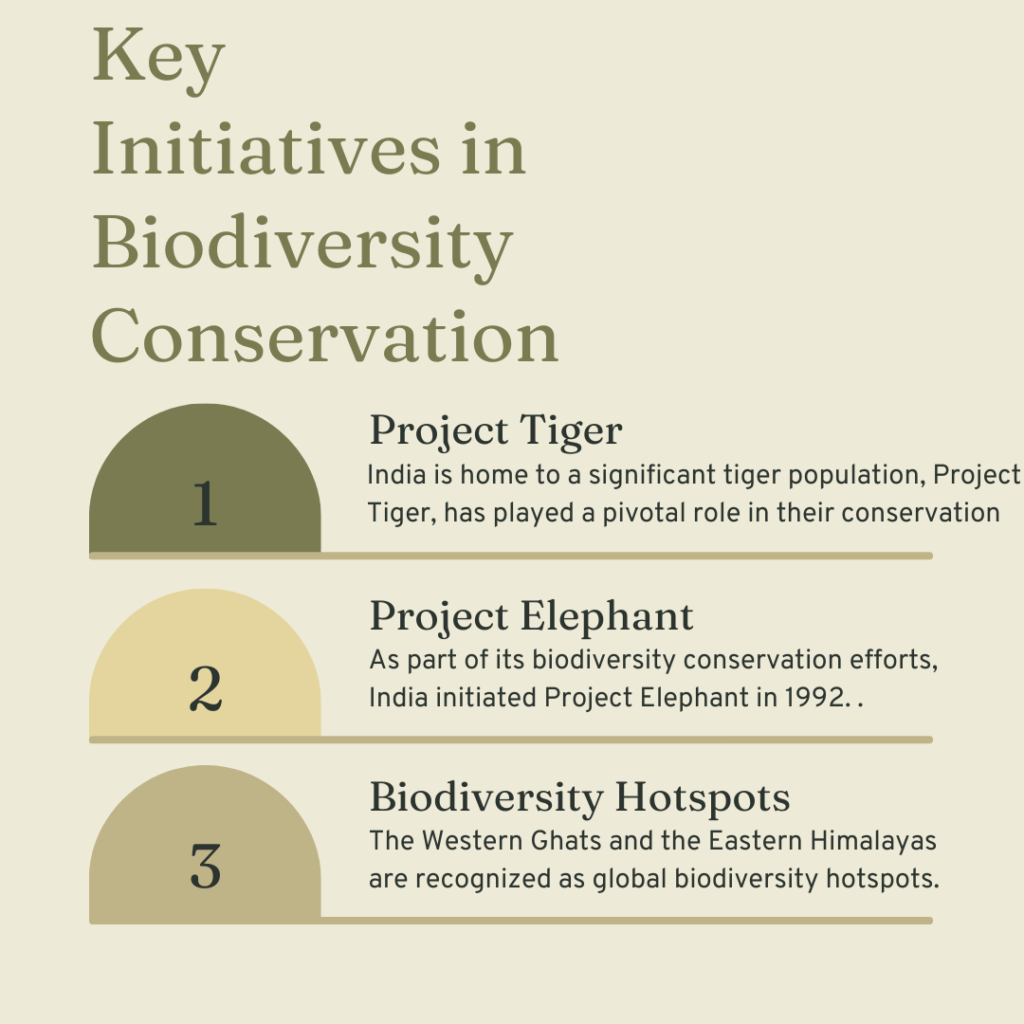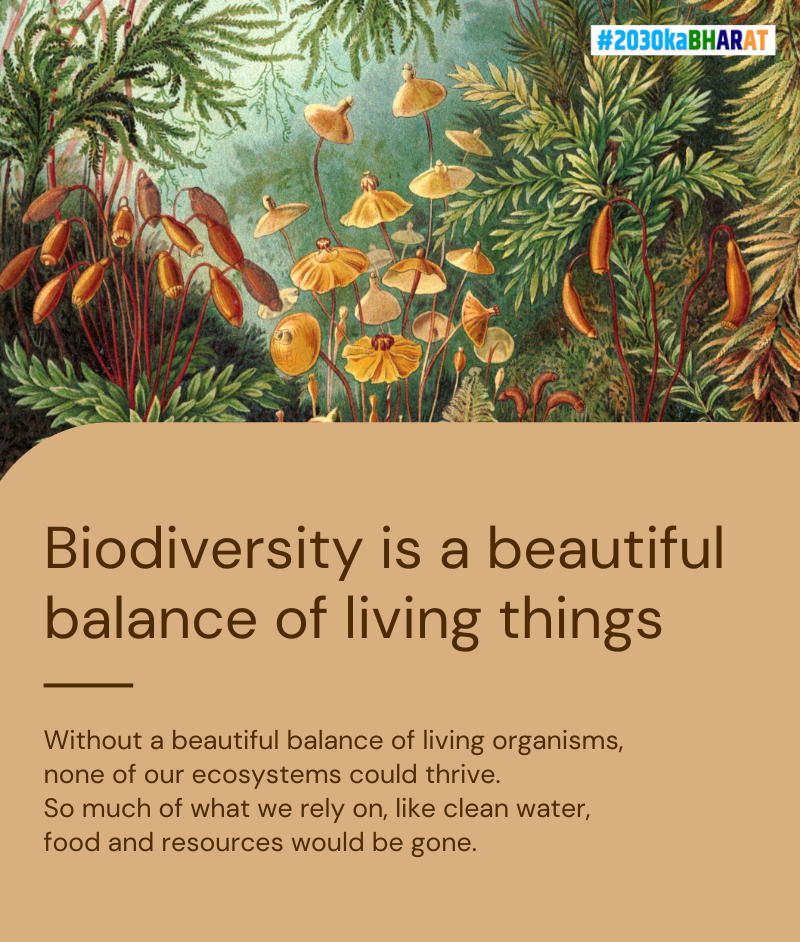Sustainable Development, India stands as a beacon of progress and innovation. Its dedication to the Sustainable Development Goals (SDGs) set forth by the United Nations is not only commendable but also exemplary. In this article, we will delve into India’s remarkable journey towards achieving the SDG goals, focusing on key initiatives, milestones, and the overarching impact on biodiversity.
Biodiversity, the variety of life on Earth, is essential for the health and well-being of our planet. The United Nations’ Sustainable Development Goals (SDGs) recognize the importance of biodiversity in achieving sustainable development by 2030. This article delves into India’s significant role in protecting biodiversity and contributing to the SDG 2030 Goals.
Biodiversity in India
India, known for its diverse landscapes, hosts a vast array of ecosystems, from the Himalayan mountain range to the coastal regions and deserts. This diversity is mirrored in the rich tapestry of flora and fauna found across the country. With over 7% of the world’s recorded species, India is one of the world’s biodiversity hotspots.
However, this wealth of biodiversity is under constant threat. Human activities, habitat destruction, pollution, and climate change pose significant risks to India’s ecosystems. The loss of biodiversity has implications for food security, water quality, and climate regulation.

Sustainable Development Goals: A Global Imperative
The Sustainable Development Goals, often referred to as the SDGs, represent a universal call to action to end poverty, protect the planet, and ensure prosperity for all by 2030. These 17 goals address a wide array of critical global challenges, ranging from poverty alleviation to environmental conservation. As the world grapples with mounting environmental issues, such as climate change and biodiversity loss, these goals have become an essential guide for countries aiming to secure a sustainable future.
India’s Commitment to Sustainable Development
India’s commitment to the SDGs is resolute. The nation has demonstrated its determination to embrace these goals through the “Sustainable Development India Report” and the ambitious “2030KaBharat” initiative. These initiatives serve as the bedrock for transformative change in the country’s development landscape.
2030KaBharat: Facing the Way for Progress
The “2030KaBharat” initiative is a visionary roadmap that encompasses all 17 SDGs. It sets clear targets, outlines strategies, and establishes a robust monitoring and evaluation framework. This initiative is a testament to India’s resolve to create a better future for its citizens and safeguard the environment. It aligns seamlessly with the global commitment to leave no one behind and protect the planet.
Protecting Biodiversity: A Cornerstone of India’s SDG Commitment
One of the standout aspects of India’s SDG journey is its unwavering dedication to protecting biodiversity. Biodiversity, the rich variety of life on Earth, is vital for the health of ecosystems and the well-being of humanity. India’s commitment to this cause is exemplified through various initiatives and policies.
Key Initiatives in Biodiversity Conservation
1. Project Tiger: India is home to a significant tiger population, and Project Tiger, launched in 1973, has played a pivotal role in their conservation. Today, India boasts a thriving tiger population and numerous protected reserves.
2. Project Elephant: As part of its biodiversity conservation efforts, India initiated Project Elephant in 1992. This project focuses on safeguarding the endangered Asian elephant and their habitats.
3. Biodiversity Hotspots: India is renowned for its diverse landscapes and ecosystems. The Western Ghats and the Eastern Himalayas are recognized as global biodiversity hotspots. These regions are of paramount importance for conservation efforts.

Protected Areas and Wildlife Sanctuaries
India’s commitment to biodiversity is evident in its extensive network of protected areas and wildlife sanctuaries. These areas serve as refuges for diverse flora and fauna, contributing to the preservation of biodiversity. Notable protected areas include the Sundarbans in West Bengal, the Jim Corbett National Park in Uttarakhand, and the Kaziranga National Park in Assam.
Innovative Conservation Measures
India has also implemented innovative conservation measures, such as the Green Corridor Project. This initiative aims to create safe passageways for wildlife, reducing human-wildlife conflicts and preserving natural habitats. It’s a striking example of India’s forward-thinking approach to biodiversity conservation.
The Role of Indigenous Communities
Indigenous communities in India play a crucial role in biodiversity conservation. Their traditional knowledge and sustainable practices have been instrumental in safeguarding the environment. India recognizes the significance of involving these communities in conservation efforts and promoting their well-being.
Impacts of India’s Biodiversity Conservation Efforts
India’s dedication to biodiversity conservation has yielded numerous positive outcomes. The recovery of endangered species, such as the Bengal tiger and Indian rhinoceros, is a testament to the success of these efforts. Moreover, the preservation of biodiversity-rich areas like the Western Ghats contributes to the overall health of the planet.
Success Stories
Several successful biodiversity conservation projects demonstrate India’s commitment to the cause. The Gir Forest National Park’s Asiatic lion conservation project, for instance, showcases how targeted efforts can revive endangered species. Similarly, the joint initiative of the Government and local communities in the Western Ghats to conserve the Nilgiri tahr illustrates the importance of involving local stakeholders in conservation projects.
These success stories underline the positive impact of biodiversity conservation on both ecosystems and local communities. The revival of endangered species contributes to the overall health of ecosystems, ensuring their resilience in the face of environmental challenges.

Future Outlook
Looking beyond 2030, India envisions a future where biodiversity conservation is integrated into every aspect of development. Policies that promote sustainable practices, enhance environmental education, and harness technology for conservation will play a crucial role. India’s commitment to protecting biodiversity is not just for the present but for future generations.
Recommendations for strengthening India’s contribution to SDG 2030 Goals include increased funding for biodiversity conservation, stronger enforcement of environmental laws, and the integration of biodiversity considerations into urban planning. Public awareness campaigns can also mobilize communities to actively participate in conservation efforts.
Global Implications
India’s commitment to protecting biodiversity is not limited to its borders. The country’s efforts have far-reaching global implications. As a mega-diverse nation, India’s actions have a significant impact on the global conservation landscape. It sets an example for other nations, demonstrating the importance of preserving biodiversity.
India’s unwavering commitment to the Sustainable Development Goals, with a particular emphasis on biodiversity conservation, is a remarkable journey. The nation’s dedication to the protection of its rich natural heritage is not only commendable but also a source of inspiration for the world. India’s progress in this arena not only contributes to the achievement of the SDG goals but also serves as a beacon of hope in the global effort to protect our planet.
By implementing effective policies, engaging in international collaboration, and learning from successful projects, India can lead the way in biodiversity conservation. The interplay between biodiversity and sustainable development is evident, emphasizing the need for holistic approaches to address the challenges of the 21st century.
As the world faces unprecedented environmental challenges, India’s commitment to protecting biodiversity stands as a beacon of hope. Through sustained efforts, innovative solutions, and international cooperation, India can contribute significantly to the global endeavor of achieving a sustainable and biodiverse future.
